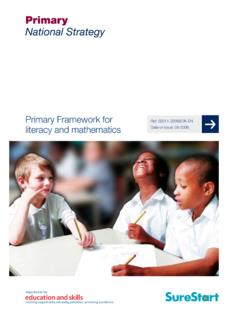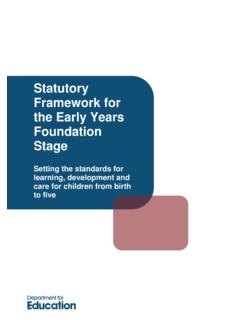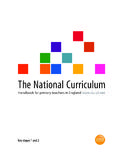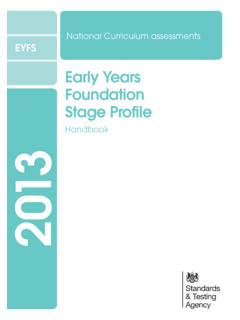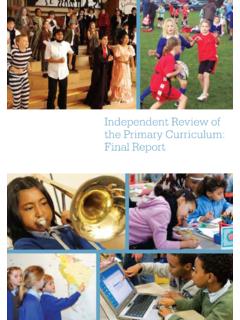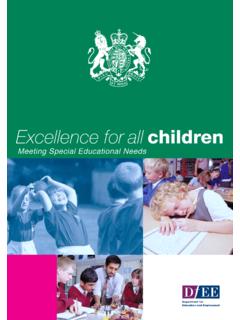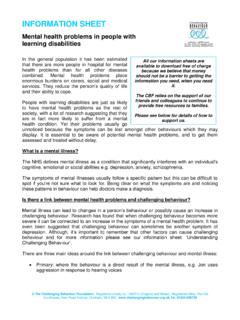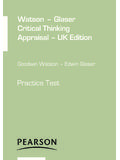Transcription of Department for Education and Skills: Five Year …
1 Department for Education and Skills: Five year strategy for Children andLearnersPutting people at the heart ofpublic servicesDepartment for Education and Skills: Five year strategy for Children andLearnersPresented to Parliament bythe Secretary of State for Education and Skillsby Command of Her MajestyJuly 2004Cm 6272 Crown Copyright 2004 The text in this document (excluding the Royal Arms and departmental logos) may bereproduced free of charge in any format or medium providing that it is reproduced accurately andnot used in a misleading context. The material must be acknowledged as Crown copyright andthe title of the document enquiries relating to the copyright in this document should be addressed to The LicensingDivision, HMSO, St Clements House, 2-16 Colegate, Norwich, NR3 1BQ. Fax: 01603 723000 or e-mail: by the Secretary of State for Education and Skills3 Executive Summary6 Chapter 1: Introduction12 Chapter 2: Early Years 20 Chapter 3: Primary Schools32 Chapter 4: Independent Specialist Schools44 Chapter 5: Personalisation and choice in the secondary years58 Chapter 6: 14 19 Education and Training68 Chapter 7: Adult Skills80 Chapter 8: Higher Education92 Chapter 9: Managing the Transformation102 Chapter 10: Conclusion110 Children, and all those who learn, are our future.
2 As we develop our strategy for the next five years for children s services, and for Education andlifelong learning, we need to think about that future about the kind of world we want ourchildren to grow up in. But we must also learn the lessons of the past. It is now sixty years since Butler s landmark 1944settlement, which raised the school-leaving age to 15, and introduced free secondary Education ,as well as shaping a lasting partnership between Church and State in Education . In the samedecade, the 1942 Beveridge Report and the 1948 Children Act transformed welfare and children sservices. These reforms were colossal; they transformed the landscape of welfare and of publicservices. Their influence is hard to over-state, and has been overwhelmingly a positive one. However, there are three key ways in which the settlement sowed the seeds for less helpfuldevelopments in public service.
3 First, the model was a monolithic one looking at the provision of social services andeducation on the same sort of basis as public services like post-war housing with the focuson a basic and standard product for , administrative divisions were sharp from the outset between health, schools, andsocial services with different systems and mechanisms developed for each. Third, the Education settlement in particular was based on an assumption that ability wasconfined to a limited group it was fundamentally elitist. Not only the grammar school system,but also the tiny proportion of young people able to go to University attested to (and cemented)this view. And despite the aspiration that there would be parity of esteem , vocational skills andtraining were, from the outset, clearly the poor relation. There were few technical schools, andsecondary moderns were seen as the sinks for those who did not make the grade for grammarschool.
4 Further Education was seen as a Cinderella service, not understood or valued by policymakers who had no first-hand experience of it; and adult skills as a whole were neglected. The move towards comprehensive Education was about challenging this elitism and givingeveryone a better deal. And evidence shows that it did help to improve standards, especiallyfor those who had been put on the scrap-heap at 11 in the selective system. But the debatewas still about types of school rather than standards the principle remained that governmentdid not interfere in how, what or how well schools taught it was enough to ensure thateducation was provided. Department FOR Education AND SKILLS: FIVE year strategy FOR CHILDREN AND LEARNERS3 Forewordby the Secretary of State for Education and SkillsJames Callaghan s Ruskin speech of 1976 began the Great Debate on school standards, withhis questions about whether the Education system was really meeting the needs of employersand society.
5 But even from here on through the National Curriculum and the birth of Ofsted the focus was on what every school ought to provide a sort of basic minimum standard. Over the last 60 years, a fundamental recasting of industry, employment, technology and societyhas transformed the requirement for Education and training not only driving the educationsystem, but introducing new ideas about lifelong learning, personalised Education , and self-directed learning. And the story has been of taking a system designed to deliver a basicminimum entitlement and elaborating and elaborating it to respond to these increasinglysophisticated (and rapidly changing) some reforms, at some times, it has been necessary and right to take a fierce grip anddeliver dramatic change quickly to make right a problem in the system. We will never apologisefor the directive action we took, for example, on literacy and numeracy in 1997 it put right anational scandal of low aspiration and poor performance.
6 But once the basics are in place andwe want to move beyond them towards excellence, we need a new sort of system that is notbased on the lowest common denominator. The central characteristic of such a new system will be personalisation so that the system fitsto the individual rather than the individual having to fit to the system. This is not a vague liberalnotion about letting people have what they want. It is about having a system which will genuinelygive high standards for all the best possible quality of children s services, which recogniseindividual needs and circumstances; the most effective teaching at school, which builds adetailed picture of what each child already knows, and how they learn, to help them go further;and, as young people begin to train for work, a system that recognises individual aptitudes andprovides as many tailored paths to employment as there are people and jobs.
7 And the corollaryof this is that the system must be both freer and more diverse with more flexibility to help meetindividual needs; and more choices between courses and types of provider, so that there reallyare different and personalised opportunities available. In order to manage this increasingly diverse and personalised system, we need good leadershipand high professional standards at all levels. We also need collaboration and partnership, so thatdiverse provision isn t incoherent or bitty, and so that people can get seamless services. And thiscannot just be a partnership of state providers the voluntary and community sector, business,and private enterprises need to be part of this partnership to provide joined-up services. This joining-up needs some local brokerage to make it work. But it implies a completely differentkind of local system.
8 Local government and local agencies must offer leadership and strategicdirection with really smart accountability but the energies of the system can no longer be tiedup in compliance or defensiveness. They must be focused on excellence. The people our wholesystem depends on those at the front line must be given the freedom to shape and reshapethe offer to meet different and changing needs. The result will be a nation where: every child gets the best possible start in life with integrated services focused on the needsof parents and children, not chopped up according to provider; every primary school offers high standards in the basics, but in the context of a broad, richand enjoyable curriculum;4 FOREWORD every secondary school offers excellent teaching, an exciting curriculum, and a positive andattractive environment; all schools are extended schools; community schools; healthy schools; inclusive schools; andenterprising schools (with real links to business); at 14-19, every young person has a pathway to suit them that fits them for work, furtherlearning, and for life as an adult; and a wide range of activities outside school or college toenjoy and take part in.
9 Every child and young person who is in difficult circumstances gets the extra support theyneed without stigma; adult learners can all get and build the skills they need for success in employment becauseemployers are in the lead in designing and delivering training, working with highly responsivecolleges; our nation benefits from a thriving university system that gives excellent teaching to all withthe potential to benefit; which provides the nation with world-class research capability; andwhich works with business to provide the skills the nation most needs and to translateresearch into innovation effectively. And where: the parts of the system are (and are seen as being) interlinked and interdependent not justbecause each builds on the last (with primary schools dependent on effective early yearseducation, secondary schools dependent on primary schools and so on) but in much morecreative and dynamic ways with business involved in designing employability skillseducation right from 11; with universities designing schemes for students in schools that bothhelp with their outreach and give new experiences to children; with schools and collegesworking together to offer routes from 14; with adult learning and childcare delivered together;with children s services and Education seen as part of one whole.
10 The learner is a partner in learning, not a passive recipient and this means that (especiallyas they grow older, leaving compulsory Education ) they have a stake in and a responsibilityfor their own learning; adult learners, employers and the wider community contribute to the Education system andto children s services so that they can get more out of them, and can shape them to meettheir needs and the needs of the all of this depends, as we have set out, on a radically reshaped system for deliveringeducation and children s services, and in particular a reshaped role for Local Government andfor my Department , moving away from direction towards an enabling and empowering depends on freedom for those at the front line to personalise services and to improve it depends on Ministers like me holding our nerve and being able to resist the lure of thenext initiative in favour of a system that drives its own improvement more and more.

